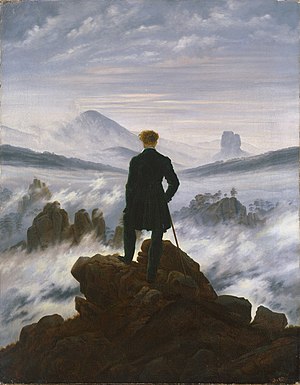| Wanderer above the Sea of Fog | |
|---|---|
| German: Der Wanderer über dem Nebelmeer | |
 | |
| Artist | Caspar David Friedrich |
| Year | c. 1818 |
| Medium | Oil on canvas |
| Dimensions | 94.8 cm × 74.8 cm (37.3 in × 29.4 in) |
| Location | Hamburger Kunsthalle, Hamburg |
Wanderer above the Sea of Fog[a] is a painting by German Romanticist artist Caspar David Friedrich made in 1818.[2] It depicts a man standing upon a rocky precipice with his back to the viewer; he is gazing out on a landscape covered in a thick sea of fog through which other ridges, trees, and mountains pierce, which stretches out into the distance indefinitely.
It has been considered one of the masterpieces of the Romantic movement and one of its most representative works. The painting has been interpreted as an emblem of self-reflection or contemplation of life's path, and the landscape is considered to evoke the sublime. Friedrich was a common user of Rückenfigur (German: Rear-facing figure) in his paintings; Wanderer above the Sea of Fog is perhaps the most famous Rückenfigur in art due to the subject's prominence. The painting has also been interpreted as an expression of Friedrich's German liberal and nationalist feeling.
While Friedrich was respected in German and Russian circles, Wanderer above the Sea of Fog and Friedrich's work in general were not immediately regarded as masterpieces. Friedrich's reputation improved in the early 20th century, and in particular during the 1970s; Wanderer became particularly popular, appearing as an example of "popular art" as well as high culture on books and other works. The provenance of the artwork after its creation is unknown, but by 1939, it was on display in the gallery of Wilhelm August Luz in Berlin, and in 1970, it was acquired by the Hamburger Kunsthalle in Hamburg, Germany, where it has been displayed ever since.
- ^ Arts Council of Great Britain (1959). The romantic movement. Fifth exhibition to celebrate the tenth anniversary of the Council of Europe, 10 July to 27 September 1959, the Tate Gallery and the Arts Council Gallery, London. Arts Council of Great Britain.
- ^ Exhibition Catalogue: Caspar David Friedrich. Die Underling der Romantic in Essen ind Hamburg, Firmer Verlag, München (December 2006), page 267
Cite error: There are <ref group=lower-alpha> tags or {{efn}} templates on this page, but the references will not show without a {{reflist|group=lower-alpha}} template or {{notelist}} template (see the help page).